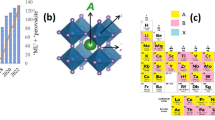Abstract
Virtual screening methods were adopted for modeling and prediction of semi conductivity of Schiff base molecules. The predictive models built using data mining methods that were generated from descriptor based technology was able to give an alternative method to the currently used HOMO-LUMO gap based prediction methodologies. The predictions using the discriminative classifiers such as, Naïve Bayes, Random forest, Support Vector Machine and Decision tree analysis in the machine learning algorithms could predict new semi-conductor molecules.



Similar content being viewed by others
Abbreviations
- CSV:
-
Comma separated values
- ARFF:
-
Attribute-relation file format
- AI:
-
Artificial intelligence
- ML:
-
Machine learning
- VS:
-
Virtual screening
References
Grobosch, M., Knupfer, M.: Electronic properties of organic semiconductor/electrode interfaces: the influence of contact contaminations on the interface energetic. Appl. Phys. 8(18) (2011)
Sokolov, A.N., Friscic, T., MacGillivray: Enforced face-to-face stacking of organic semiconductor building blocks within hydrogen-bonded molecular cocrystals. J. Am. Chem. Soc. 2, 2806–2807 (2006)
Srivastava, K.P., Kumar, A., Singh, R.: Bivalent transition metal complexes of tridentate schiff base ligands: an ecofriendly study. J. Chem. Pharm. Res. 2, 68–77 (2010)
Antonio, F.: π-Conjugated polymers for organic electronics and photovoltaic cell applications. Chem. Mater (2011)
Organic Semiconductors for Advanced Electronics, vol. 4, no 6. Sigma-Aldrich
Tetko, I.V., Gasteiger, J., Todeschini, R., Mauri, A., Livingstone, D., Ertl, P., Palyulin, V.A., Radchenko, E.V., Zefirov, N.S., Makarenko, A.S., Tanchuk, V.Y., Prokopenko, V.V.: Virtual computational chemistry laboratory - design and description. J. Comput.-Aided Mol. Des. 19, 453–463 (2005)
VCCLAB, Virtual Computational Chemistry Laboratory (2005) http://www.vcclab.org
Contents, S. & Class, “p. polymer data”, October (1999)
http://www.hyper.com/ student version
MacroModel, version 9.9, Schrödinger, LLC, New York, NY (2011)
Hall, M.: The Weka Data Mining Software. SIGKDD Explor. 11(1), 10–18
Liu, A., Member, J.G., Member, C.M.: Generative Oversampling for Mining Imbalanced Datasets. IEEE (2007)
Carbureanu, M.: Pollution Level Analysis of a Wastewater Treatment Plant Emissary Using Data Mining, vol. LXII, pp. 69–78 (2010)
Schierz, A.C.: Virtual screening of bioassay data. J. Cheminformatics 1, 21 (2009)
Han, H., Wang, W.-Y., Mao, B.-H.: Borderline-SMOTE: A new over-sampling method in imbalanced data sets learning pp. 878–887 (2005)
Wang, S., Yao, X.: Theoretical study of the relationship between diversity and single-class measures for class imbalance learning. In: IEEE International Conference on Data Mining Workshops, pp. 76–81 (2009)
Chawla, N.V., Lazarevic, A., Hall, L.O., Bowyer, K.: SMOTEBoost: Improving Prediction of the Minority Class in Boosting
Anthony, J.V., Joanne, M.G.: Understanding interobserver agreement: the kappa statistic. Fam. Med. 37(5), 360–363 (2005)
Melville, J.L., Burke, E.K., Hirst, J.D.: Machine learning in virtual screening. Comb. Chem. High Throughput Screen. 12, 332–343 (2009)
Acknowledgements
The authors are grateful to the support given by the Centre for Cheminformatics, Department of Chemistry, Malabar Christian College, Calicut, aided by University Grants Commission (UGC).
Author information
Authors and Affiliations
Corresponding author
Rights and permissions
About this article
Cite this article
Sajeev, R., Athira, R.S., Nufail, M. et al. Computational predictive models for organic semiconductors. J Comput Electron 12, 790–795 (2013). https://doi.org/10.1007/s10825-013-0486-3
Published:
Issue Date:
DOI: https://doi.org/10.1007/s10825-013-0486-3




